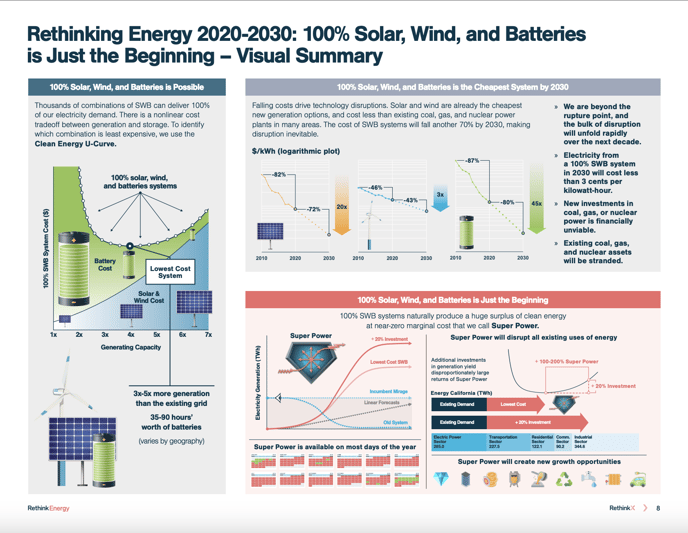RethinkX | 6 May 2024
Since publishing our landmark findings in 2020, many other research teams around the world have reached similar conclusions, that 100% solar, wind and battery-based systems (SWB) are possible, and by far the most affordable energy system for our future.
Beyond the findings of our core analysis, it is also worth recognizing that the critique of solar and wind power on the basis of their utilization rate has never been valid. The validity of investments in energy assets, like any other asset class, are determined by their economic value, not by arbitrary standards of physical efficiency. If a low utilization rate invalidated the use of an energy asset, that would apply to conventional technologies as well as SWB-and we already have hundreds of billions of dollars in conventional generating assets that are only utilized a small amount of the time.
For example, California already only uses its full electric power generating capacity about 50% of the time. And peakers, or power plants that are only used during periods of peak demand, are typically utilized less than 10% of the time. Yet the low utilization rate of gas-powered peakers did not prevent society from investing in them.
Moreover, virtually all regions worldwide require by law that power plant utilities maintain a significant operating reserve, meaning a legally mandated excess of capacity, just in case there is unexpectedly more demand than ever before. Some of this operating reserve is required to be spinning reserve (i.e. the generators are actively spinning) which can be deployed near-instantly if needed. A portion of power plant (typically gas) hours are dedicated to providing spinning reserves, meaning that they literally sit there burning fuel just in case it is ever needed on a moment’s notice! So, in addition to a low utilization rate, spinning reserves based on fossil fuels are also very costly and wasteful-unlike equivalent reserves of SWB which do not burn fuels when in standby mode.
Read our SWB regional analysis.


Policymakers, investors, civic leaders and the general public are under the false impression that it is impossible for solar photovoltaics and wind power to supply 100% of the electricity in the United States without weeks’ worth of battery energy storage. This widespread misconception has been created by the failure of conventional models and forecasts to understand that future solar and wind generating capacity will greatly exceed the total electricity generating capacity installed today. Read more on p9 of our Rethinking Energy report.
A 100% SWB system would naturally produce a very large quantity of near-zero marginal cost super power. The superabundance of near-zero marginal cost electricity that results from clean energy super power will have a transformative impact on energy markets, energy-related and energy-intensive industries, and the economy as a whole. We call this SWB Superpower.
100% solar photovoltaics, onshore wind power and lithium-ion batteries are not only possible, but inevitable for nations all over the world. SWB does not operate by the traditional rules of extractive and polluting resources that have governed humanity’s relationship with energy for over a century.